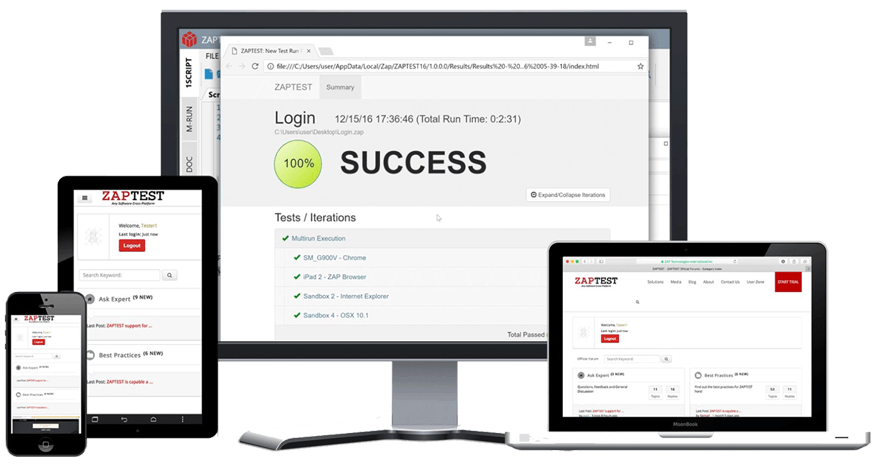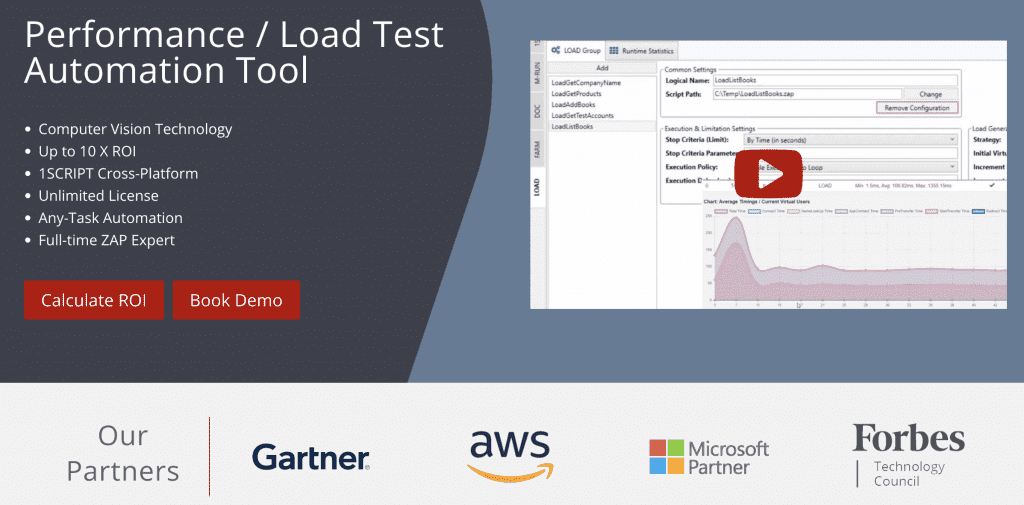In this article, we will be examining what performance testing is alongside the many types and performance testing tools available, the challenges and benefits involved with performance testing, and much more. This comprehensive guide will also include an analysis of automated performance testing which is becoming more common as technology advances even further.
What is performance testing?
Performance testing, sometimes shortened to ‘perf testing’, is a process carried out to identify whether a certain product will perform its expected processes well under different workloads. This can take the form of website performance testing or performance testing in software testing, depending on the product involved.
Performance testing is mainly designed to detect malfunctioning product parameters which can be changed early on in the product’s life cycle to avoid bigger problems going forward. This is often referred to as locating bottlenecks, which refers to a single component that holds back the overall performance of the software.
Performance testing can be performed in a lab or in a production environment and usually assesses the speed, rate, scalability, stability, responsiveness, and reliability of the product.
Is performance testing different from functional testing?

Perf testing is different from functional testing, which tests whether certain functions on an application work, such as the “add to basket” button on an online store.
Performance testing looks at how well a function works under a lot of pressure i.e. load testing, for example, would the button still work if many people were adding to the basket at once?
Both of these types of tests come under the API testing performance testing umbrella, which means that their purpose is to determine the overall performance of a system’s interface under certain circumstances, from the backend of the software. There are many types of API performance testing tools that this article will consider, such as workload model performance testing.
Why do we need performance testing?
Web performance tests are essential so that developers can provide stakeholders with reliable information about the application’s performance and predict how it will respond to different levels of traffic.
Performance testing also reveals what needs to be improved before the product hits the shelves or after it has been made live, avoiding slow performance, inconsistencies and poor usability. It tests against expected user numbers so that it can be relied upon to function as expected.
Benefits of performance testing
We have already briefly mentioned the benefits of performance testing just by identifying what it is, but we will run through a list of the specific benefits of performance testing below.
1. Realistic information
As mentioned briefly above, performance testing is used to provide stakeholders with reliable, realistic information about how the application will perform. Without this, there is a risk of a damaged reputation for the company involved.
Accurate performance testing means that dependable figures can be provided which, through the testing process, can be improved, meaning the product may have an advantage over different products on the market and back these up with reliable performance, resulting in increased sales.
2. Allows for preparation
Performance testing can be used to identify where software-related failures may happen when there are high numbers of users, meaning the application can then be optimised so that these problems are solved and can withstand higher usage. This is ideal for eCommerce sites, for instance, which may need to prepare for predictably major events such as Black Friday.
Carrying out performance testing avoids crashes while the site is up at critical moments. An online store that can’t cope with the number of users on Black Friday, taking too long to load or glitching, is likely to miss out on big profits.
3. Improved user experience
Performance testing should be carried out regularly for the most high-performing website or software to continue its expected function. Continuous performance testing means that any issues that may arise in real time are solved as soon as possible. The importance of this is rooted in user experience testing, even outside of the major events that we outlined above.
If the website is consistently user-friendly, with improvements to ensure it never falls behind, customers will frequently visit.
4. Comparing
Performance testing can also be used to compare one product against another one. This can be helpful for a developer heading into a very competitive industry who wants to ensure they are equal to or can outperform their main competitor on the market.
This can be used as a selling point to gain an advantage or simply as a benchmark during the testing process to ensure that the application works well enough.
Challenges and limitations of performance testing
Although there are clearly a number of significant benefits, due to its complex nature there are some challenges and limitations of performance testing that we will outline below.
1. Time
To reap all of these benefits, organisations have to be willing to put time aside for performance testing. This could include setting up hardware and infrastructure that they weren’t expecting or dedicating employees to performance testing.
For performance testing to be thorough, it should not be rushed…this is not necessarily an agile testing process. Some companies may find it difficult to put that time aside instead of launching into the next phase of the project, as it can lead to lengthy delays. It is why at ZAPTEST we advocate the importance of every company developing a Test Center of Excellence, which will both enhance productivity and will develop teh testing process in a more agile undertaking.
2. Money
There are costly investments that have to be made in performance testing. The price of the performance testing tool depends on the scale of the website or software, and whether the organisation opts for manual or automated performance testing tools.
Free performance testing tools do exist, but they have limited functionality and do not work as well as paid ones.
In addition, performance testing can reveal unexpected issues that require costly upgrades or additional system capacity that were not factored into the budget at first.
For smaller businesses, performance testing tools may be expenses they are not willing to pay despite the fact that it could hugely affect their performance in the long term.
3. Limitations of tools
There could be limitations depending on the performance testing tool that a developer opts for.
As we have mentioned, opting for a free performance testing tool saves the budget but it might miss out on crucial aspects. Some tools, even paid ones, may have limited compatibility, for example, some may only be able to support website performance testing or a browser performance test, and not be capable of software performance testing.
And, some performance testing tools may find it difficult to test complex or very large applications and require close monitoring by employees.
Types of performance testing
There are multiple types of performance testing which refers to the methods used to test the system. The method used is chosen based on the scale and type of system being tested, as well as the intended goals that the developers are aiming for.
Here, we will identify the main types of performance testing used and how they work.
1. Load testing
Load performance testing tools enable developers to understand how the system would behave under a pre-determined, specific load value.
This process involves the simulation of the expected number of concurrent users over a duration of time. This verifies the expected response times of the application and identifies potential bottlenecks before the website or software goes live. This can be done to test if the system can handle expected usage in general, or to test how a specific functionality would cope, like the “add to basket” example we mentioned above. This is sometimes called “unit testing”.
2. Stress testing
Stress testing is another form of workload model performance testing and can often be done using the same tools, but it pushes the site to increase in testing capacity until it breaks rather than having a limited, determined load value.
This uses higher-than-expected traffic so that developers can find out what its failure point is and see how it handles high levels of data processing. This helps developers to understand the scalability of the software and shows how long key performance indicators (KPIs) take to return to normal operational levels after a large data event.
Stress testing can occur before or after a system goes live.
3. Spike testing
This is a subset of stress testing, but more specifically analyses the performance of the system under a sudden, significant increase of end users. These performance tests help to determine if the system could handle an abrupt change in users over a short period of time, repeatedly.
4. Soak testing
This type of performance testing is also known as endurance testing, and it is designed to test a system’s long-term performance and how well it can cope over time. They analyse throughput and response times after long-term use to check if performance metrics are consistent throughout and if there are any failures.
What should we test via performance testing?
The purpose of performance testing is to be able to spot issues but knowing what is causing them is the main goal.
See below for a list of the things that are mainly tested via performance testing.
1. Bottlenecks
Performance testing should always be on the lookout for bottlenecks that are affecting the overall performance of the system. This can be related to any of the performance testing metrics that we will list in the next section.
2. Load times
This means the allotment required to begin the application. The delay should be as short as possible to offer the best user experience – anything more than a few seconds of loading time may send users away.
3. Response times
A poor response time is when the time that elapses between a user entering the information and the response to the action is too long. Like excessive load times, this will frustrate a user and encourage them to leave the site or application.
4. Scalability
The scalability of a system should be tested, meaning its adaptability to different demands of data usage. Limited scalability would be identified if the system can perform well with a few concurrent users but, during load or stress testing, deteriorates when the user number increases.
Performance testing metrics
It is one thing to be able to test these things and see when they are going wrong, but how exactly are they measured?
There are countless amounts of metrics that developers use for performance testing, so we have selected the main ones and given a brief description for them below.
1. Throughput
This indicates how many units of information the system is able to process over a specified time.
2. Memory use
Memory in terms of a website or software development means the working storage space that is available to the processor or workload.
3. Bandwidth
This means the volume of data per second that can move between workloads, often across a network. Poor bandwidth results in poor loading times.
4. CPU interrupts per second
This measures the impact the hardware has on the process, measuring the number of hardware interrupts it receives per second.
Characteristics of an effective performance test
A good performance test will allow developers to act on the mistakes, but the specific characteristics of an effective performance test are more specific and difficult to attain than this.
1. Realistic testing
The best performance tests are those which anticipate real scenarios that the system may encounter.
This means that it can be optimised to work under conditions that it has been designed to do, so it can meet its performance goals and not encounter issues at critical moments.
2. Fast analysis
The optimum performance tests allow for changes to be made according to the results as soon as possible.
Although it needs to be thorough, the data should be easy to analyse and be carried out as soon as possible so that actions can be taken. This is especially important if the testing has taken place after the application or site is live.
3. Reliable results
Although speed is important to optimise the performance testing process, the data produced needs to be reliable and accurate so that correct decision-making can take place.
To produce reliable and fast analysis, many are turning to automated performance testing, which we will go into more detail about later.
Performance testing process
The performance testing process will differ for every organisation depending on the factors we have already identified.
However, there are six main steps that outline what most performance testing processes will follow that will allow for an effective outcome.
1. Performance testing strategies
The first step to beginning a performance testing process is to know the testing environment. Know which testing tools you have available, including a decision over whether it will be carried out manually or automated, and identify potential performance testing strategies.
Ensure you understand the details of any hardware and software involved, as well as any network configurations that will be used.
2. Performance criteria
Next, it is essential to identify the goals of the test and the success criteria you are working towards, which will be different for every test. For example, identify throughput constraints, and expected response times and allocate resources.
At this point, it may be beneficial to identify a similar system to compare to in order to set performance goals.
3. Performance test plan
Once the criteria have been identified, you can begin the planning and designing of the performance test.
Determine what usage the application is likely to get and key scenarios you can simulate to ensure the system responds appropriately. Plan the performance test data you are intending to gain, how you will gain it and what metrics will be used.
4. Performance test design
Once all of the planning is comprehensively finished, you can begin to physically design and configure the test environment and arrange the tools and resources needed, including test data management.
Then, create the performance tests according to the design, ready for them to begin running.
5. Test
This is the point where the performance test will be executed. It is important that you monitor the process as it goes along and creates logs documenting KPIs throughout.
6. Analyse and retest
Consolidate the results and begin the analysis process.
How did it compare to your expectations, what metrics were measured, and how did the system respond? Then, modify the performance test and test again to identify improvements or decreases in performance. Improvements should decrease with each retest.
Log all ongoing results.
Performance Test Examples

There are many potential performance testing scenarios depending on the system being tested, its purpose, the tools used, and the type of performance testing.
Let’s revisit our eCommerce site example.
eCommerce site
The developers may wish to use workload model performance testing to verify that the response time is not more than three seconds when 2000 users access the website concurrently using a load test.
The next step could be to verify that the response time is still within an acceptable range of five seconds when the network connectivity is slow.
In preparation for Black Friday, the developers may use a stress test to identify the maximum number of users the site can accommodate before it experiences failures like crashing or very slow response times. During this, they will check the memory and CPU usage of the website and how the database server is reacting under peak load conditions.
They will then retest all of these parameters under a range of conditions, perhaps using spike testing or soak testing to identify how it will respond throughout different time frames.
Developers will also use unit testing of the “add to basket” function, for example, testing how the system would respond to 100 users completing a transaction at once. This test could be applied to a variety of platforms like Linux, Windows, Android, iOS, web, QA tests, and more!
Should you automate performance testing?
Automated performance testing is the process of allowing pre-made tools, software and code to run the automation process rather than carrying it out manually.
Performance testing automation is becoming indispensable in modern times, with some organisations making use of Robotic Process Automation and some even moving towards hyperautomation.
Performance testing automation software has a host of both benefits and drawbacks which we will outline below.
Benefits of automated performance tests
Performance testing removes a lot of the time and money that may be spent creating testing code and manually repeating it, increasing the efficiency of the testing cycle.
It also often means that developers can start the performance test and move on to do something else, rather than constantly monitoring it, making remote working possible and meaning tests can even be run overnight.
In addition, as we have already mentioned, because of the nature of automation, the performance testing process does not just become faster but more accurate and reliable, able to complete comprehensive processes without the risk of human error.
All of these factors of course save businesses valuable time and money, often boasting a higher return on investment.
Limitations of automated performance tests
Automated performance tests may have limitations on what they can realistically achieve. The input of a human will often be required for very sophisticated tests, and to correct the errors that may occur with an automated process.
Human observation can be essential to spotting glitches and helping improve the customer experience, which cannot be guaranteed with automation testing.
Manual testing is often better suited for exploratory, usability, and ad hoc testing.
Conclusion: manual vs. automated performance testing
To choose between manual and automated performance testing, you need to closely evaluate your performance criteria and budget. Automated performance testing is often more budget-friendly and quicker, especially for large testing needs, but manual testing can find problems that an automated system cannot.
Performance testing tools
There are many types of performance testing tools but they can be mainly separated into two categories: API performance testing tools and UI performance testing tools.
API performance testing tools analyse whether the correct processes are being met in the backend of the application. REST API performance testing tools are a specific type that performs a web performance test by sending various HTTP/S requests.
On the other hand, UI performance testing tools test the client side, meaning the user experience is evaluated.
The best tools for performance testing are ones that do both of these because they offer a fully comprehensive view of if the system works. As well as this, there are both free tools and paid, enterprise-level performance testing automation software available, so how do you decide?
Free performance testing tools: benefits and limitations
There are a number of free performance testing services on the market.
The obvious benefit to these is that they open up performance testing to smaller businesses or startups that may not have the budget to pay for an enterprise testing tool. This means they can access basic performance testing capabilities and edit their system accordingly.
However, the limitations of free performance testing automation software are that they often don’t perform as well as paid ones. Their functionalities will likely be limited, and it will be more difficult to develop and maintain scripts.
Free performance testing tools may not be compatible with all platforms or testing types or may not have a reporting function. Some features may be locked behind a paywall, such as access to API testing.
Enterprise performance testing tools: benefits and limitations
Enterprise performance testing tools are software designed to operate throughout a business. They are often worth their price tag in that they are likely to be compatible with many testing types, languages, and platforms for increased flexibility and scalability.
Enterprise performance testing tools are powerful so can perform bigger tests in a lower time frame and come with future maintenance updates to improve performance that free versions may not. Think of Enterprise level tools as full stack testing software that can run regression tests, unit testing, integration testing, and any other type of software testing an Enterprise would require it to.
However, businesses may not have the budget to set aside for these performance testing services, especially for software that has many features that they will not use or if their business is relatively small.
Enterprise performance testing tools may also be harder to access and slower to implement than simple, free versions.
However, leading software testing tools like ZAPTEST mitigate this limitation by offering a tool + service model. In this way, a ZAP expert works closely and remotely with the client organization (as part of their team), supporting them the with implementation of the performance testing plan, ZAPTEST tool, and with optimising the testing process.
When should you use enterprise vs. free performance test tools?
Evaluate your options based on your organisation’s circumstances. It can sometimes be more cost-effective to opt for a free version that features the main functionalities that you require, for instance for a one-off test of a website.
If you are part of a large organisation that could benefit from a complex, data-dense testing system that you will use many times for different systems, an enterprise performance test tool will likely help you the most.
Performance Testing Checklist
1. Budget
To determine the best tool for performance testing, it is necessary to have a detailed budget in place to be able to identify if you can afford an enterprise-level or other paid version.
Do your research into the different tools available and make your decision based on your performance criteria and test environment.
2. Plan
Once your budget is in place, you can plan out the performance testing process, such as choosing the best strategy, deciding what criteria you are testing and deciding which metrics to use.
The planning process should be thorough whether you opt for manual or automated performance testing.
3. Analyse
Carry out the performance test with close analysis throughout the test and afterwards.
For a performance test to be effective, you need to be able to act on it in the best possible way, so take a close look at the data and continue to test and analyse into the system’s life.
Conclusion
We have run through some of the types and tools of performance testing as well as the key benefits and limitations of performance testing.
Performance testing remains especially important because online systems and applications usage is not slowing down and is in fact gaining speed and having a system that can cope with large amounts of pressure is more important than ever in the face of huge competition.
To stay at the forefront of innovation, large businesses should consider the benefits of enterprise-level performance testing and RPA automation software and how investing in it could benefit them in the long term.










